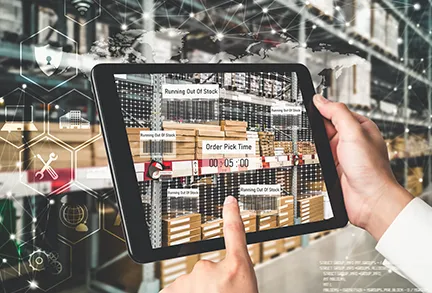Preparing for Automation: The Data You Need to Collect and Why It’s So Important
Caveat emptor is the principle that a buyer should be cautious to the possibility of being cheated. You can avoid risks involved with automating your warehouse by knowing what questions you and potential vendors or consultants should ask up-front.
One of the most tedious steps in adopting warehouse automation is also the most important — collecting data that accurately reflects your current warehouse operation and desired growth you expect to achieve. Although it may seem time-consuming, I’ll offer a strong caveat emptor, aka “buyer beware,” to anyone not taking the time to do proper due diligence before they invest in robotics or other material handling and logistics technologies. Here are some questions your vendors or consultants should be asking right from the start:
Questions that your vendor or consultant should be asking you
1. What are your load units?
A load unit is a single, huge quantity of items moved as one unit to reduce the handling and shipping cost of multiple stock keeping units (SKUs). They’re usually arranged on a modular support or in packaging (box, pallet, container, etc.), and they’re handled at working locations such as a general warehouse, reserve warehouse, or picking warehouse with carton flow racks, in-house transport equipment, etc.
After receiving, a load unit is broken down into smaller elements to be picked, packed, and delivered to a customer. When automating, it’s important to know if your products are large or small. Generally speaking, conveyable or totable products will fall into a small category. Large products will be non-conveyable and are often heavy or oddly shaped. Ideally, vendors or consultants will want to know the dimensional data on each of your SKUs, which will make it much easier to perform a cubic analysis. Make sure they ask for details about the size, weight, shape, fragility, and case quantities of your products.
2. What are your throughput requirements?
Sharing order data containing order number, orderlines, unit counts, and date of order will allow vendors and consultants to evaluate the recent historical throughputs achieved in your current operation. These data points should span both peak and average periods, usually resulting in over three months of order data. With the goal of implementing a future-proof automated solution, they'll also need to understand what the growth targets are for your business. For solutions like AutoStore™, this data will help determine the type and number of robots required to meet your warehouse's needs.
3. What are your storage requirements?
Next, one should consider the environment that the products need to be stored in. Are there temperature-controlled, chilled, or freezer requirements? If so, it should be noted early, as only some automation solutions can operate in these conditions. Hazardous and caustic inventory should also be called out to make sure it's suitable for automated material handling. Additionally, inventory segmentation is important to understand if you need to isolate products and handle them at specific workstations. An example would be if you sold sensitive electronics and need to design a dedicated electrostatic discharge zone within the warehouse system.
4. What is your warehouse layout and configuration?
Share the detailed layout and configuration of your warehouse, including the size, shape, and clear height of the facility, as well as the locations of doors, docks, and storage areas. This information will help vendors and consultants understand the best ways to design the material flow and install the technology. One important note: It’s essential to plan your automation system out before finalizing construction documents for greenfield (new) locations. At this stage, architects and engineers should be engaged with your system integration consultants and vendors.
5. What is your order profile?
In addition to calculating throughput requirements, a vendor or consultant will be able to calculate order size distribution and ABC structure from the data collected in Questions #2. Knowing which SKUs account for the majority of your sales will allow them to optimally slot your product. Effective slotting is critical to an efficient fulfillment operation and an understanding of dynamic slotting options will position you for success.
6. What existing warehouse systems and infrastructure do you currently use?
Share information about the existing systems and infrastructure in your warehouse, such as conveyor systems, automated storage and retrieval systems (AS/RS), or WMS. This data will help the vendor determine how automated technology can be integrated with the existing infrastructure
7. What are your safety requirements?
Share information about the safety standards and regulations that need to be met in your warehouse. This information will help your team design and develop a safe and reliable system that meets the requirements.
Theoretical proof or actual simulation? The big question you need to ask your vendor or consultant
The last question should be for you to ask whether they offer theoretical or actual simulations to prove out design concepts. System providers sometimes speak about peak machine speeds, such as “up to 1,000 picks per hour,” however the reality is pick speeds are process-dependent. Make sure to understand the full picture, including what task operators are doing with the automated machinery and what bottlenecks they might encounter, in order to truly achieve a rate. Simulations show whether the design will meet your operational needs. It's optimal to use the same software used on the live system for these simulations with inputs calculated from your existing operation.
How does AutoStore prepare customers for warehouse automation?
At AutoStore, we use a System Concept Design Requirements form to accurately record warehouse dimensions and layout, Bin count and distribution, order structure, handling times, required performance, process description, and shift structures. This form helps supplement the data collection process and guide operators into filling gaps within their available data.
The data are analyzed and the outputs are used to lay out a suitable Grid with our proprietary AutoStore Grid Designer software. We then import that design into our Design Simulator software to validate that it will satisfy your needs. The combination of outputs from these tools are a visual proof-of-concept animation that is reviewed in detail with our partners and end customers. The process also validates whether AutoStore is, in fact, a right fit for a particular customer before making any purchase agreements. Here’s a closer look at the required information, the reasons for requesting it, and how we calculate various data points:
.png)
AutoStore Grid Designer is used in conjunction with our system integrator partners around the world to rapidly concept and validate automated warehouse solutions. Find out more about how it works in this webinar by Mark Hasler.
Warehouse dimensions and layout
The AutoStore system is modular and flexible and should be designed to fit within the available space of the warehouse while taking into account any obstacles, such as pillars, mezzanines, and other existing infrastructure. The available height of the warehouse should also be considered to maximize the use of vertical space.
Bin count and distribution
The number and size of Bins required will depend on the size and quantity of the products to be stored. Bin distribution should be calculated based on the total orders or requests per SKU, using customer order data from a period of at least one to three months, including peak periods.
Order structure
The total lines, or SKUs per order, should also be calculated using customer order data from a period of at least one to three months. This data will help to determine the most efficient order picking strategy.
Handling times
The handling times for picking and goods-in should be considered when calculating the Port capacity of the AutoStore system. This will ensure that the system can handle the required volume of products efficiently.
Required performance
The required average and peak performance of the AutoStore system should be determined based on a growth factor applied to orderlines taken from historical data. This will help to ensure that the system can meet the demands of the warehouse.
Process description
The AutoStore system should be integrated with other warehouse operations, such as order processing, shipping, VAS, order staging/pickup and receiving, and all integrated third-party technologies, such as conveyors, put walls, pick-to-light systems, robotic piece picking arms, sorters, right-size packaging equipment, etc. The same integration will be required on the software to ensure the existing systems seamlessly pass commands to all required pieces of equipment.
Shift structure
Having an idea of your labor availability will allow you to define a work structure that can be staffed to maximize the use of your Autostore.
Summary
Warehouse and logistics professionals know that successful automation projects always start with some basic up-front questions like those I just described. A red flag should go up if you didn’t have this conversation with your vendor or consultant. Doing the proper due diligence will give all sides a better understanding of your warehouse's requirements and enable you to design an automated warehouse solution that meets your needs. Bottom line: asking the right questions from the start should help you identify the right people and technologies for your automation project.
“Doing the proper due diligence will give all sides a better understanding of your warehouse's requirements and enable you to design an automated warehouse solution that meets your needs. Bottom line: asking the right questions from the start should help you identify the right people and technologies for your automation project.”





















